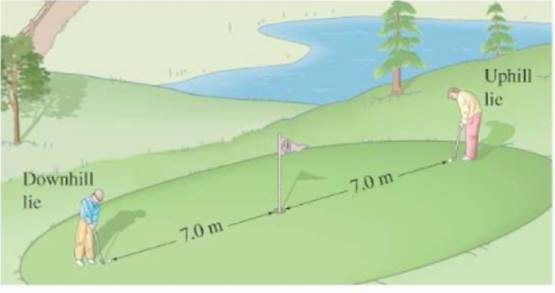
Concept explainers
The allowable ranges of initial velocities a golfer may impart to the ball from the uphill and downhill.
To explain: The reason for the considering downhill putt more difficult.
Answer to Problem 67GP
For uphill lie, initial velocity for
Explanation of Solution
Given:
The given situation is shown below.

The final velocity of the ball in both the cases is
Formula used:
Using Newton’s third law of motion,
Calculation:
Calculate for the uphill lie.
The initial velocity of the ball when it is
The initial velocity of the ball when it is
Calculate for the downhill lie.
The initial velocity of the ball when it is
The initial velocity of the ball when it is
The spread of acceptable velocities for the uphill is
The spread of acceptable velocities for the downhill is
Conclusion:
Thus, the initial velocity of the ball when ball is being putted down the hill for
Chapter 2 Solutions
Physics: Principles with Applications
Additional Science Textbook Solutions
Physics (5th Edition)
Lecture- Tutorials for Introductory Astronomy
University Physics with Modern Physics (14th Edition)
College Physics
The Cosmic Perspective
An Introduction to Thermal Physics
 College PhysicsPhysicsISBN:9781305952300Author:Raymond A. Serway, Chris VuillePublisher:Cengage Learning
College PhysicsPhysicsISBN:9781305952300Author:Raymond A. Serway, Chris VuillePublisher:Cengage Learning University Physics (14th Edition)PhysicsISBN:9780133969290Author:Hugh D. Young, Roger A. FreedmanPublisher:PEARSON
University Physics (14th Edition)PhysicsISBN:9780133969290Author:Hugh D. Young, Roger A. FreedmanPublisher:PEARSON Introduction To Quantum MechanicsPhysicsISBN:9781107189638Author:Griffiths, David J., Schroeter, Darrell F.Publisher:Cambridge University Press
Introduction To Quantum MechanicsPhysicsISBN:9781107189638Author:Griffiths, David J., Schroeter, Darrell F.Publisher:Cambridge University Press Physics for Scientists and EngineersPhysicsISBN:9781337553278Author:Raymond A. Serway, John W. JewettPublisher:Cengage Learning
Physics for Scientists and EngineersPhysicsISBN:9781337553278Author:Raymond A. Serway, John W. JewettPublisher:Cengage Learning Lecture- Tutorials for Introductory AstronomyPhysicsISBN:9780321820464Author:Edward E. Prather, Tim P. Slater, Jeff P. Adams, Gina BrissendenPublisher:Addison-Wesley
Lecture- Tutorials for Introductory AstronomyPhysicsISBN:9780321820464Author:Edward E. Prather, Tim P. Slater, Jeff P. Adams, Gina BrissendenPublisher:Addison-Wesley College Physics: A Strategic Approach (4th Editio...PhysicsISBN:9780134609034Author:Randall D. Knight (Professor Emeritus), Brian Jones, Stuart FieldPublisher:PEARSON
College Physics: A Strategic Approach (4th Editio...PhysicsISBN:9780134609034Author:Randall D. Knight (Professor Emeritus), Brian Jones, Stuart FieldPublisher:PEARSON





